Comprehensive Brand Management Report: Marks and Spencer Analysis
VerifiedAdded on 2022/12/26
|19
|5990
|78
Report
AI Summary
This report provides a comprehensive analysis of brand management, focusing on the strategies employed by Marks and Spencer (M&S). It explores the importance of branding as a marketing tool, examining how it has evolved in business practices and its role in differentiating products and services. The report delves into the key components of successful brand strategies, including brand equity, and evaluates how brands are managed over time using relevant theories and models. It covers portfolio management, brand hierarchies, and brand equity, critically analyzing these aspects using appropriate frameworks. Furthermore, the report investigates how companies collaborate and form partnerships at national and international levels to leverage and extend brands. Finally, it examines techniques for analyzing and managing brand value within an organizational context, particularly in relation to developing a strong and enduring brand, using the CBBE model. The report concludes with an assessment of M&S's brand management practices and their impact on its market position.
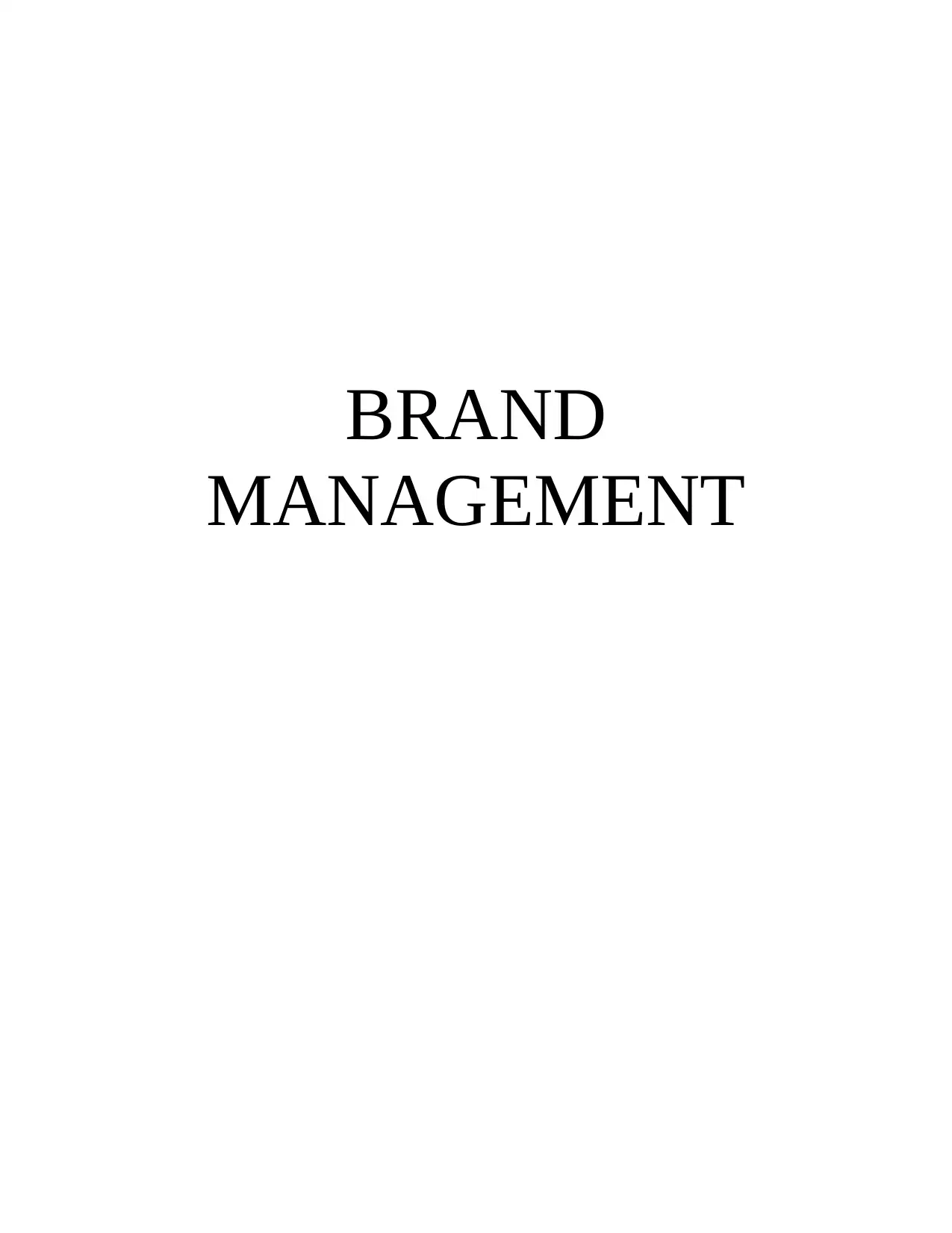
BRAND
MANAGEMENT
MANAGEMENT
Paraphrase This Document
Need a fresh take? Get an instant paraphrase of this document with our AI Paraphraser
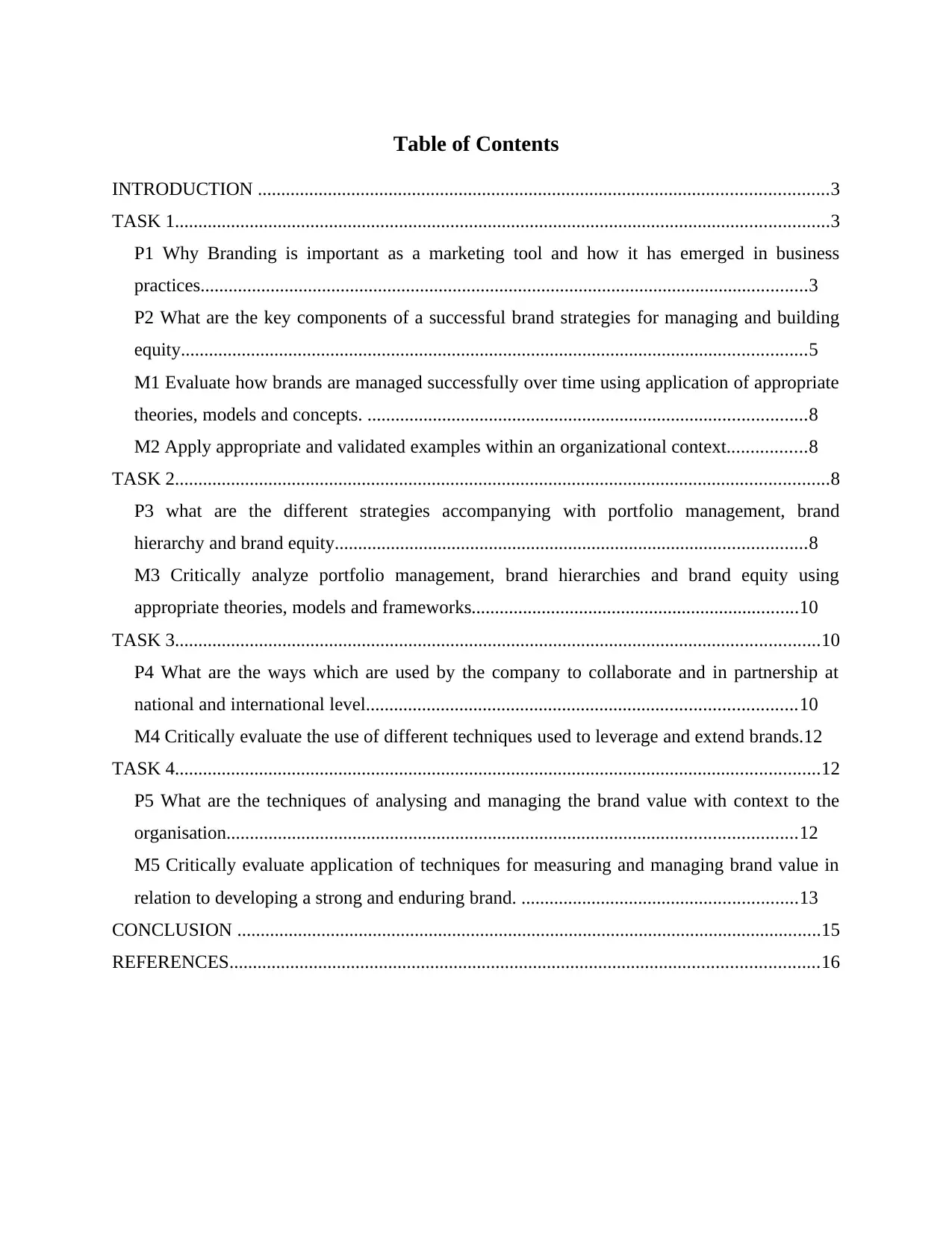
Table of Contents
INTRODUCTION ..........................................................................................................................3
TASK 1............................................................................................................................................3
P1 Why Branding is important as a marketing tool and how it has emerged in business
practices..................................................................................................................................3
P2 What are the key components of a successful brand strategies for managing and building
equity......................................................................................................................................5
M1 Evaluate how brands are managed successfully over time using application of appropriate
theories, models and concepts. ..............................................................................................8
M2 Apply appropriate and validated examples within an organizational context.................8
TASK 2............................................................................................................................................8
P3 what are the different strategies accompanying with portfolio management, brand
hierarchy and brand equity.....................................................................................................8
M3 Critically analyze portfolio management, brand hierarchies and brand equity using
appropriate theories, models and frameworks......................................................................10
TASK 3..........................................................................................................................................10
P4 What are the ways which are used by the company to collaborate and in partnership at
national and international level............................................................................................10
M4 Critically evaluate the use of different techniques used to leverage and extend brands.12
TASK 4..........................................................................................................................................12
P5 What are the techniques of analysing and managing the brand value with context to the
organisation..........................................................................................................................12
M5 Critically evaluate application of techniques for measuring and managing brand value in
relation to developing a strong and enduring brand. ...........................................................13
CONCLUSION .............................................................................................................................15
REFERENCES..............................................................................................................................16
INTRODUCTION ..........................................................................................................................3
TASK 1............................................................................................................................................3
P1 Why Branding is important as a marketing tool and how it has emerged in business
practices..................................................................................................................................3
P2 What are the key components of a successful brand strategies for managing and building
equity......................................................................................................................................5
M1 Evaluate how brands are managed successfully over time using application of appropriate
theories, models and concepts. ..............................................................................................8
M2 Apply appropriate and validated examples within an organizational context.................8
TASK 2............................................................................................................................................8
P3 what are the different strategies accompanying with portfolio management, brand
hierarchy and brand equity.....................................................................................................8
M3 Critically analyze portfolio management, brand hierarchies and brand equity using
appropriate theories, models and frameworks......................................................................10
TASK 3..........................................................................................................................................10
P4 What are the ways which are used by the company to collaborate and in partnership at
national and international level............................................................................................10
M4 Critically evaluate the use of different techniques used to leverage and extend brands.12
TASK 4..........................................................................................................................................12
P5 What are the techniques of analysing and managing the brand value with context to the
organisation..........................................................................................................................12
M5 Critically evaluate application of techniques for measuring and managing brand value in
relation to developing a strong and enduring brand. ...........................................................13
CONCLUSION .............................................................................................................................15
REFERENCES..............................................................................................................................16
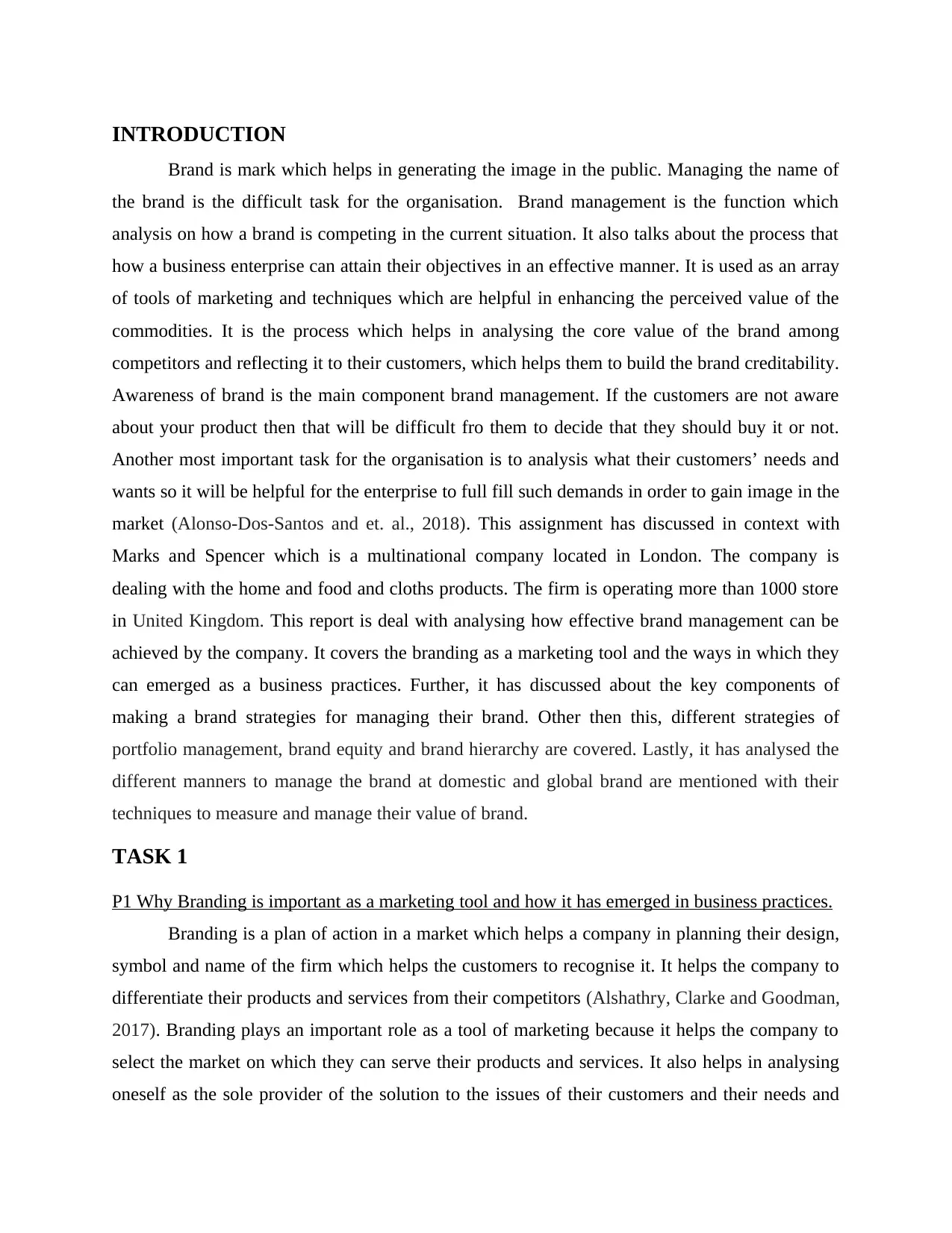
INTRODUCTION
Brand is mark which helps in generating the image in the public. Managing the name of
the brand is the difficult task for the organisation. Brand management is the function which
analysis on how a brand is competing in the current situation. It also talks about the process that
how a business enterprise can attain their objectives in an effective manner. It is used as an array
of tools of marketing and techniques which are helpful in enhancing the perceived value of the
commodities. It is the process which helps in analysing the core value of the brand among
competitors and reflecting it to their customers, which helps them to build the brand creditability.
Awareness of brand is the main component brand management. If the customers are not aware
about your product then that will be difficult fro them to decide that they should buy it or not.
Another most important task for the organisation is to analysis what their customers’ needs and
wants so it will be helpful for the enterprise to full fill such demands in order to gain image in the
market (Alonso-Dos-Santos and et. al., 2018). This assignment has discussed in context with
Marks and Spencer which is a multinational company located in London. The company is
dealing with the home and food and cloths products. The firm is operating more than 1000 store
in United Kingdom. This report is deal with analysing how effective brand management can be
achieved by the company. It covers the branding as a marketing tool and the ways in which they
can emerged as a business practices. Further, it has discussed about the key components of
making a brand strategies for managing their brand. Other then this, different strategies of
portfolio management, brand equity and brand hierarchy are covered. Lastly, it has analysed the
different manners to manage the brand at domestic and global brand are mentioned with their
techniques to measure and manage their value of brand.
TASK 1
P1 Why Branding is important as a marketing tool and how it has emerged in business practices.
Branding is a plan of action in a market which helps a company in planning their design,
symbol and name of the firm which helps the customers to recognise it. It helps the company to
differentiate their products and services from their competitors (Alshathry, Clarke and Goodman,
2017). Branding plays an important role as a tool of marketing because it helps the company to
select the market on which they can serve their products and services. It also helps in analysing
oneself as the sole provider of the solution to the issues of their customers and their needs and
Brand is mark which helps in generating the image in the public. Managing the name of
the brand is the difficult task for the organisation. Brand management is the function which
analysis on how a brand is competing in the current situation. It also talks about the process that
how a business enterprise can attain their objectives in an effective manner. It is used as an array
of tools of marketing and techniques which are helpful in enhancing the perceived value of the
commodities. It is the process which helps in analysing the core value of the brand among
competitors and reflecting it to their customers, which helps them to build the brand creditability.
Awareness of brand is the main component brand management. If the customers are not aware
about your product then that will be difficult fro them to decide that they should buy it or not.
Another most important task for the organisation is to analysis what their customers’ needs and
wants so it will be helpful for the enterprise to full fill such demands in order to gain image in the
market (Alonso-Dos-Santos and et. al., 2018). This assignment has discussed in context with
Marks and Spencer which is a multinational company located in London. The company is
dealing with the home and food and cloths products. The firm is operating more than 1000 store
in United Kingdom. This report is deal with analysing how effective brand management can be
achieved by the company. It covers the branding as a marketing tool and the ways in which they
can emerged as a business practices. Further, it has discussed about the key components of
making a brand strategies for managing their brand. Other then this, different strategies of
portfolio management, brand equity and brand hierarchy are covered. Lastly, it has analysed the
different manners to manage the brand at domestic and global brand are mentioned with their
techniques to measure and manage their value of brand.
TASK 1
P1 Why Branding is important as a marketing tool and how it has emerged in business practices.
Branding is a plan of action in a market which helps a company in planning their design,
symbol and name of the firm which helps the customers to recognise it. It helps the company to
differentiate their products and services from their competitors (Alshathry, Clarke and Goodman,
2017). Branding plays an important role as a tool of marketing because it helps the company to
select the market on which they can serve their products and services. It also helps in analysing
oneself as the sole provider of the solution to the issues of their customers and their needs and
⊘ This is a preview!⊘
Do you want full access?
Subscribe today to unlock all pages.

Trusted by 1+ million students worldwide
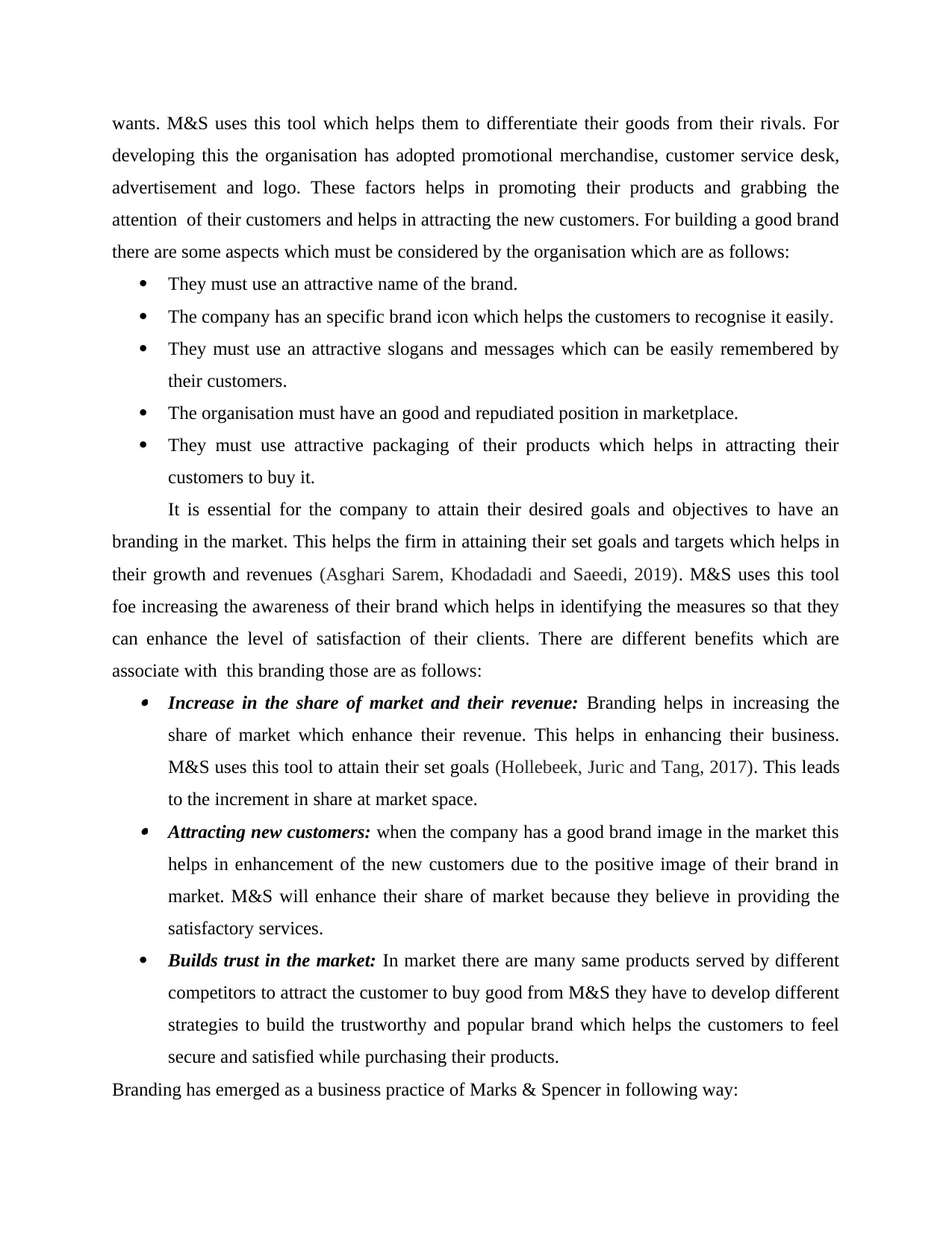
wants. M&S uses this tool which helps them to differentiate their goods from their rivals. For
developing this the organisation has adopted promotional merchandise, customer service desk,
advertisement and logo. These factors helps in promoting their products and grabbing the
attention of their customers and helps in attracting the new customers. For building a good brand
there are some aspects which must be considered by the organisation which are as follows:
They must use an attractive name of the brand.
The company has an specific brand icon which helps the customers to recognise it easily.
They must use an attractive slogans and messages which can be easily remembered by
their customers.
The organisation must have an good and repudiated position in marketplace.
They must use attractive packaging of their products which helps in attracting their
customers to buy it.
It is essential for the company to attain their desired goals and objectives to have an
branding in the market. This helps the firm in attaining their set goals and targets which helps in
their growth and revenues (Asghari Sarem, Khodadadi and Saeedi, 2019). M&S uses this tool
foe increasing the awareness of their brand which helps in identifying the measures so that they
can enhance the level of satisfaction of their clients. There are different benefits which are
associate with this branding those are as follows: Increase in the share of market and their revenue: Branding helps in increasing the
share of market which enhance their revenue. This helps in enhancing their business.
M&S uses this tool to attain their set goals (Hollebeek, Juric and Tang, 2017). This leads
to the increment in share at market space. Attracting new customers: when the company has a good brand image in the market this
helps in enhancement of the new customers due to the positive image of their brand in
market. M&S will enhance their share of market because they believe in providing the
satisfactory services.
Builds trust in the market: In market there are many same products served by different
competitors to attract the customer to buy good from M&S they have to develop different
strategies to build the trustworthy and popular brand which helps the customers to feel
secure and satisfied while purchasing their products.
Branding has emerged as a business practice of Marks & Spencer in following way:
developing this the organisation has adopted promotional merchandise, customer service desk,
advertisement and logo. These factors helps in promoting their products and grabbing the
attention of their customers and helps in attracting the new customers. For building a good brand
there are some aspects which must be considered by the organisation which are as follows:
They must use an attractive name of the brand.
The company has an specific brand icon which helps the customers to recognise it easily.
They must use an attractive slogans and messages which can be easily remembered by
their customers.
The organisation must have an good and repudiated position in marketplace.
They must use attractive packaging of their products which helps in attracting their
customers to buy it.
It is essential for the company to attain their desired goals and objectives to have an
branding in the market. This helps the firm in attaining their set goals and targets which helps in
their growth and revenues (Asghari Sarem, Khodadadi and Saeedi, 2019). M&S uses this tool
foe increasing the awareness of their brand which helps in identifying the measures so that they
can enhance the level of satisfaction of their clients. There are different benefits which are
associate with this branding those are as follows: Increase in the share of market and their revenue: Branding helps in increasing the
share of market which enhance their revenue. This helps in enhancing their business.
M&S uses this tool to attain their set goals (Hollebeek, Juric and Tang, 2017). This leads
to the increment in share at market space. Attracting new customers: when the company has a good brand image in the market this
helps in enhancement of the new customers due to the positive image of their brand in
market. M&S will enhance their share of market because they believe in providing the
satisfactory services.
Builds trust in the market: In market there are many same products served by different
competitors to attract the customer to buy good from M&S they have to develop different
strategies to build the trustworthy and popular brand which helps the customers to feel
secure and satisfied while purchasing their products.
Branding has emerged as a business practice of Marks & Spencer in following way:
Paraphrase This Document
Need a fresh take? Get an instant paraphrase of this document with our AI Paraphraser
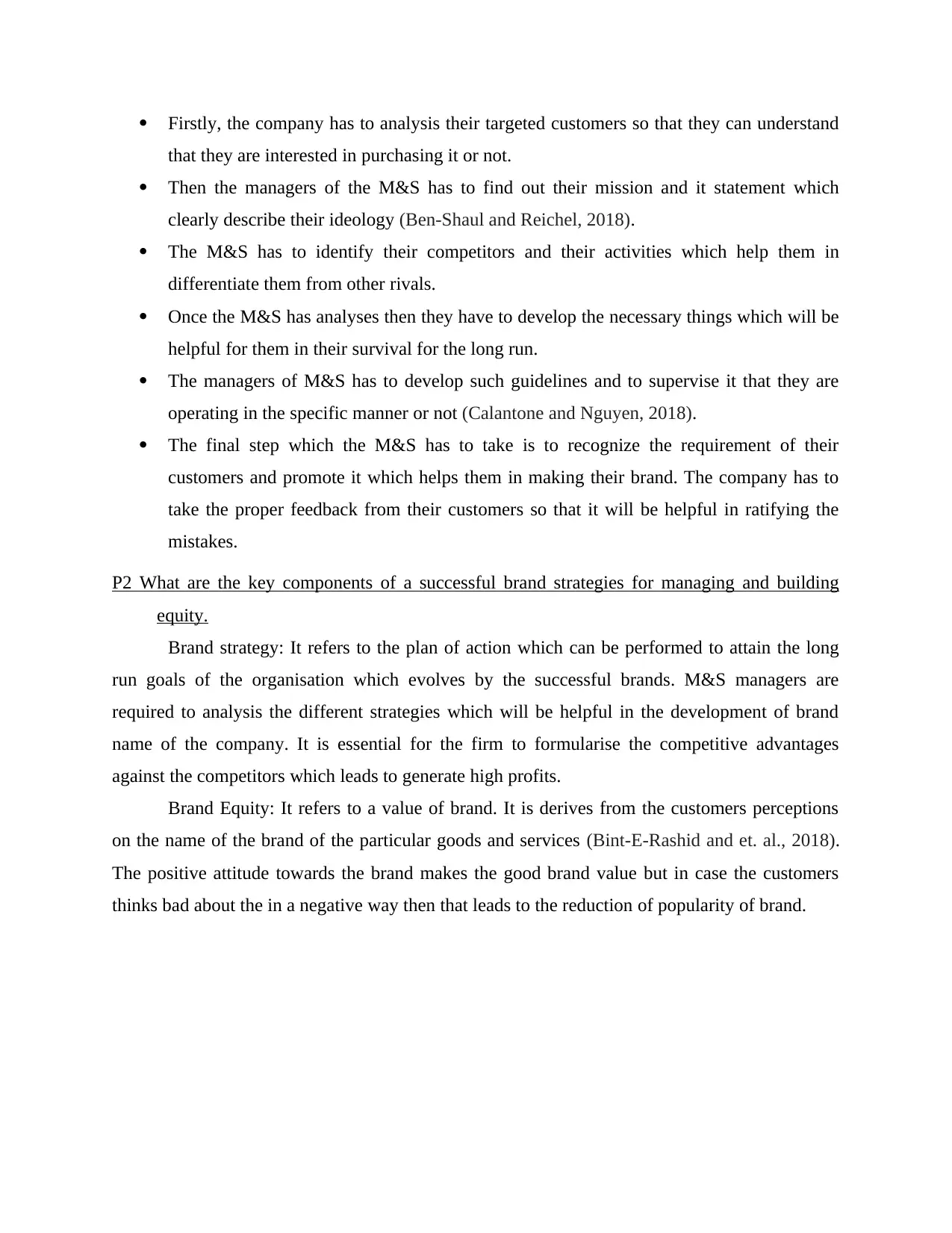
Firstly, the company has to analysis their targeted customers so that they can understand
that they are interested in purchasing it or not.
Then the managers of the M&S has to find out their mission and it statement which
clearly describe their ideology (Ben-Shaul and Reichel, 2018).
The M&S has to identify their competitors and their activities which help them in
differentiate them from other rivals.
Once the M&S has analyses then they have to develop the necessary things which will be
helpful for them in their survival for the long run.
The managers of M&S has to develop such guidelines and to supervise it that they are
operating in the specific manner or not (Calantone and Nguyen, 2018).
The final step which the M&S has to take is to recognize the requirement of their
customers and promote it which helps them in making their brand. The company has to
take the proper feedback from their customers so that it will be helpful in ratifying the
mistakes.
P2 What are the key components of a successful brand strategies for managing and building
equity.
Brand strategy: It refers to the plan of action which can be performed to attain the long
run goals of the organisation which evolves by the successful brands. M&S managers are
required to analysis the different strategies which will be helpful in the development of brand
name of the company. It is essential for the firm to formularise the competitive advantages
against the competitors which leads to generate high profits.
Brand Equity: It refers to a value of brand. It is derives from the customers perceptions
on the name of the brand of the particular goods and services (Bint-E-Rashid and et. al., 2018).
The positive attitude towards the brand makes the good brand value but in case the customers
thinks bad about the in a negative way then that leads to the reduction of popularity of brand.
that they are interested in purchasing it or not.
Then the managers of the M&S has to find out their mission and it statement which
clearly describe their ideology (Ben-Shaul and Reichel, 2018).
The M&S has to identify their competitors and their activities which help them in
differentiate them from other rivals.
Once the M&S has analyses then they have to develop the necessary things which will be
helpful for them in their survival for the long run.
The managers of M&S has to develop such guidelines and to supervise it that they are
operating in the specific manner or not (Calantone and Nguyen, 2018).
The final step which the M&S has to take is to recognize the requirement of their
customers and promote it which helps them in making their brand. The company has to
take the proper feedback from their customers so that it will be helpful in ratifying the
mistakes.
P2 What are the key components of a successful brand strategies for managing and building
equity.
Brand strategy: It refers to the plan of action which can be performed to attain the long
run goals of the organisation which evolves by the successful brands. M&S managers are
required to analysis the different strategies which will be helpful in the development of brand
name of the company. It is essential for the firm to formularise the competitive advantages
against the competitors which leads to generate high profits.
Brand Equity: It refers to a value of brand. It is derives from the customers perceptions
on the name of the brand of the particular goods and services (Bint-E-Rashid and et. al., 2018).
The positive attitude towards the brand makes the good brand value but in case the customers
thinks bad about the in a negative way then that leads to the reduction of popularity of brand.
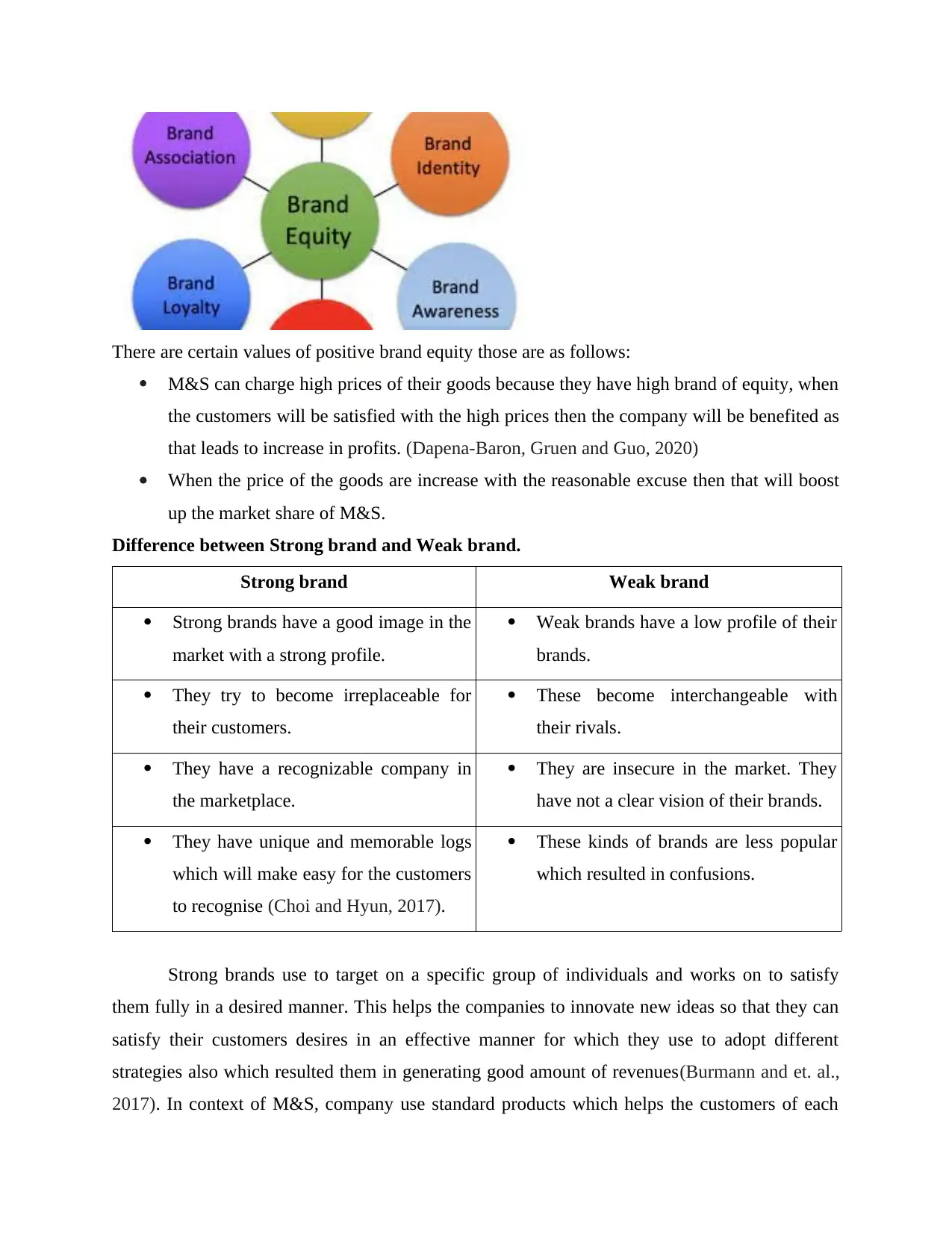
There are certain values of positive brand equity those are as follows:
M&S can charge high prices of their goods because they have high brand of equity, when
the customers will be satisfied with the high prices then the company will be benefited as
that leads to increase in profits. (Dapena-Baron, Gruen and Guo, 2020)
When the price of the goods are increase with the reasonable excuse then that will boost
up the market share of M&S.
Difference between Strong brand and Weak brand.
Strong brand Weak brand
Strong brands have a good image in the
market with a strong profile.
Weak brands have a low profile of their
brands.
They try to become irreplaceable for
their customers.
These become interchangeable with
their rivals.
They have a recognizable company in
the marketplace.
They are insecure in the market. They
have not a clear vision of their brands.
They have unique and memorable logs
which will make easy for the customers
to recognise (Choi and Hyun, 2017).
These kinds of brands are less popular
which resulted in confusions.
Strong brands use to target on a specific group of individuals and works on to satisfy
them fully in a desired manner. This helps the companies to innovate new ideas so that they can
satisfy their customers desires in an effective manner for which they use to adopt different
strategies also which resulted them in generating good amount of revenues(Burmann and et. al.,
2017). In context of M&S, company use standard products which helps the customers of each
M&S can charge high prices of their goods because they have high brand of equity, when
the customers will be satisfied with the high prices then the company will be benefited as
that leads to increase in profits. (Dapena-Baron, Gruen and Guo, 2020)
When the price of the goods are increase with the reasonable excuse then that will boost
up the market share of M&S.
Difference between Strong brand and Weak brand.
Strong brand Weak brand
Strong brands have a good image in the
market with a strong profile.
Weak brands have a low profile of their
brands.
They try to become irreplaceable for
their customers.
These become interchangeable with
their rivals.
They have a recognizable company in
the marketplace.
They are insecure in the market. They
have not a clear vision of their brands.
They have unique and memorable logs
which will make easy for the customers
to recognise (Choi and Hyun, 2017).
These kinds of brands are less popular
which resulted in confusions.
Strong brands use to target on a specific group of individuals and works on to satisfy
them fully in a desired manner. This helps the companies to innovate new ideas so that they can
satisfy their customers desires in an effective manner for which they use to adopt different
strategies also which resulted them in generating good amount of revenues(Burmann and et. al.,
2017). In context of M&S, company use standard products which helps the customers of each
⊘ This is a preview!⊘
Do you want full access?
Subscribe today to unlock all pages.

Trusted by 1+ million students worldwide
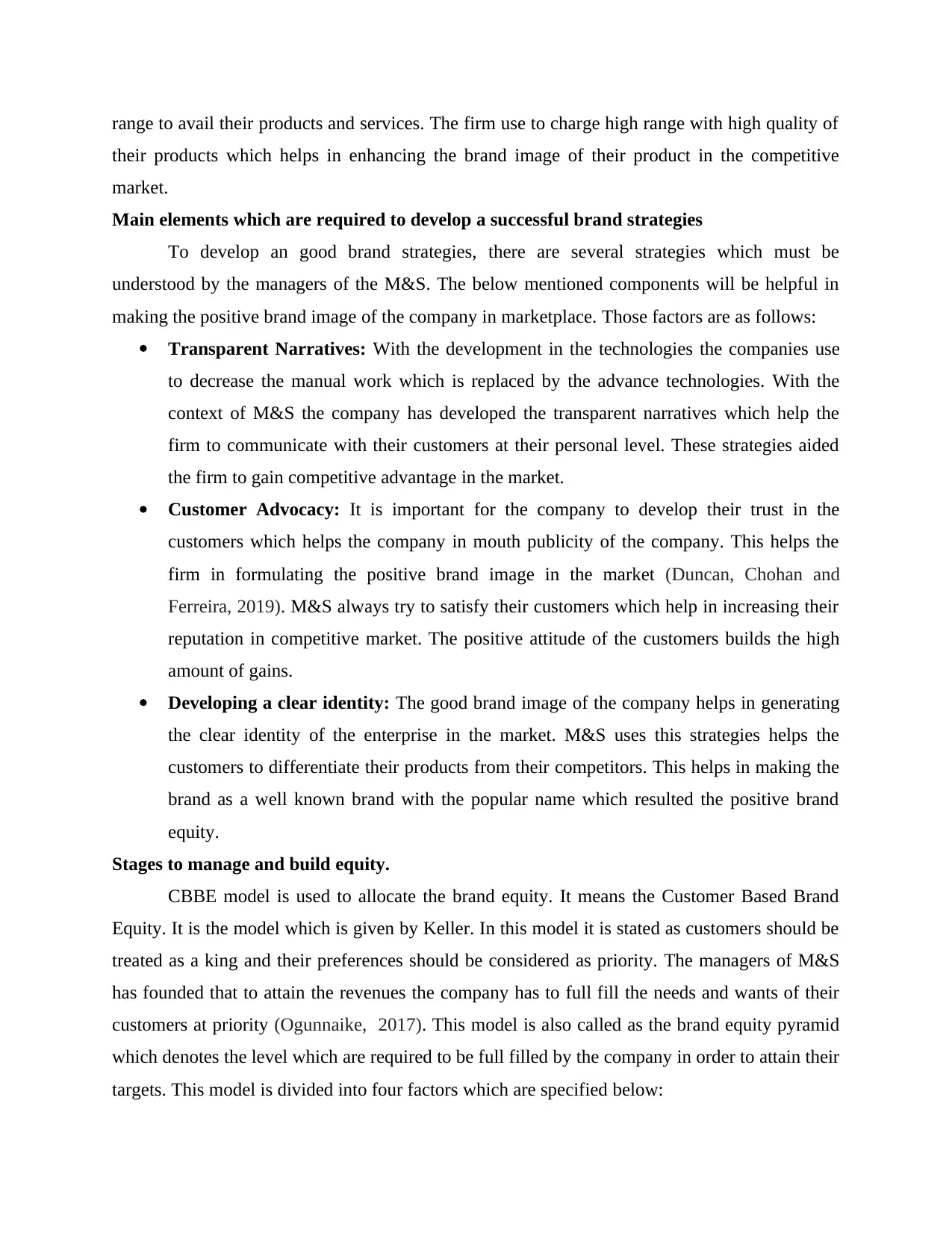
range to avail their products and services. The firm use to charge high range with high quality of
their products which helps in enhancing the brand image of their product in the competitive
market.
Main elements which are required to develop a successful brand strategies
To develop an good brand strategies, there are several strategies which must be
understood by the managers of the M&S. The below mentioned components will be helpful in
making the positive brand image of the company in marketplace. Those factors are as follows:
Transparent Narratives: With the development in the technologies the companies use
to decrease the manual work which is replaced by the advance technologies. With the
context of M&S the company has developed the transparent narratives which help the
firm to communicate with their customers at their personal level. These strategies aided
the firm to gain competitive advantage in the market.
Customer Advocacy: It is important for the company to develop their trust in the
customers which helps the company in mouth publicity of the company. This helps the
firm in formulating the positive brand image in the market (Duncan, Chohan and
Ferreira, 2019). M&S always try to satisfy their customers which help in increasing their
reputation in competitive market. The positive attitude of the customers builds the high
amount of gains.
Developing a clear identity: The good brand image of the company helps in generating
the clear identity of the enterprise in the market. M&S uses this strategies helps the
customers to differentiate their products from their competitors. This helps in making the
brand as a well known brand with the popular name which resulted the positive brand
equity.
Stages to manage and build equity.
CBBE model is used to allocate the brand equity. It means the Customer Based Brand
Equity. It is the model which is given by Keller. In this model it is stated as customers should be
treated as a king and their preferences should be considered as priority. The managers of M&S
has founded that to attain the revenues the company has to full fill the needs and wants of their
customers at priority (Ogunnaike, 2017). This model is also called as the brand equity pyramid
which denotes the level which are required to be full filled by the company in order to attain their
targets. This model is divided into four factors which are specified below:
their products which helps in enhancing the brand image of their product in the competitive
market.
Main elements which are required to develop a successful brand strategies
To develop an good brand strategies, there are several strategies which must be
understood by the managers of the M&S. The below mentioned components will be helpful in
making the positive brand image of the company in marketplace. Those factors are as follows:
Transparent Narratives: With the development in the technologies the companies use
to decrease the manual work which is replaced by the advance technologies. With the
context of M&S the company has developed the transparent narratives which help the
firm to communicate with their customers at their personal level. These strategies aided
the firm to gain competitive advantage in the market.
Customer Advocacy: It is important for the company to develop their trust in the
customers which helps the company in mouth publicity of the company. This helps the
firm in formulating the positive brand image in the market (Duncan, Chohan and
Ferreira, 2019). M&S always try to satisfy their customers which help in increasing their
reputation in competitive market. The positive attitude of the customers builds the high
amount of gains.
Developing a clear identity: The good brand image of the company helps in generating
the clear identity of the enterprise in the market. M&S uses this strategies helps the
customers to differentiate their products from their competitors. This helps in making the
brand as a well known brand with the popular name which resulted the positive brand
equity.
Stages to manage and build equity.
CBBE model is used to allocate the brand equity. It means the Customer Based Brand
Equity. It is the model which is given by Keller. In this model it is stated as customers should be
treated as a king and their preferences should be considered as priority. The managers of M&S
has founded that to attain the revenues the company has to full fill the needs and wants of their
customers at priority (Ogunnaike, 2017). This model is also called as the brand equity pyramid
which denotes the level which are required to be full filled by the company in order to attain their
targets. This model is divided into four factors which are specified below:
Paraphrase This Document
Need a fresh take? Get an instant paraphrase of this document with our AI Paraphraser
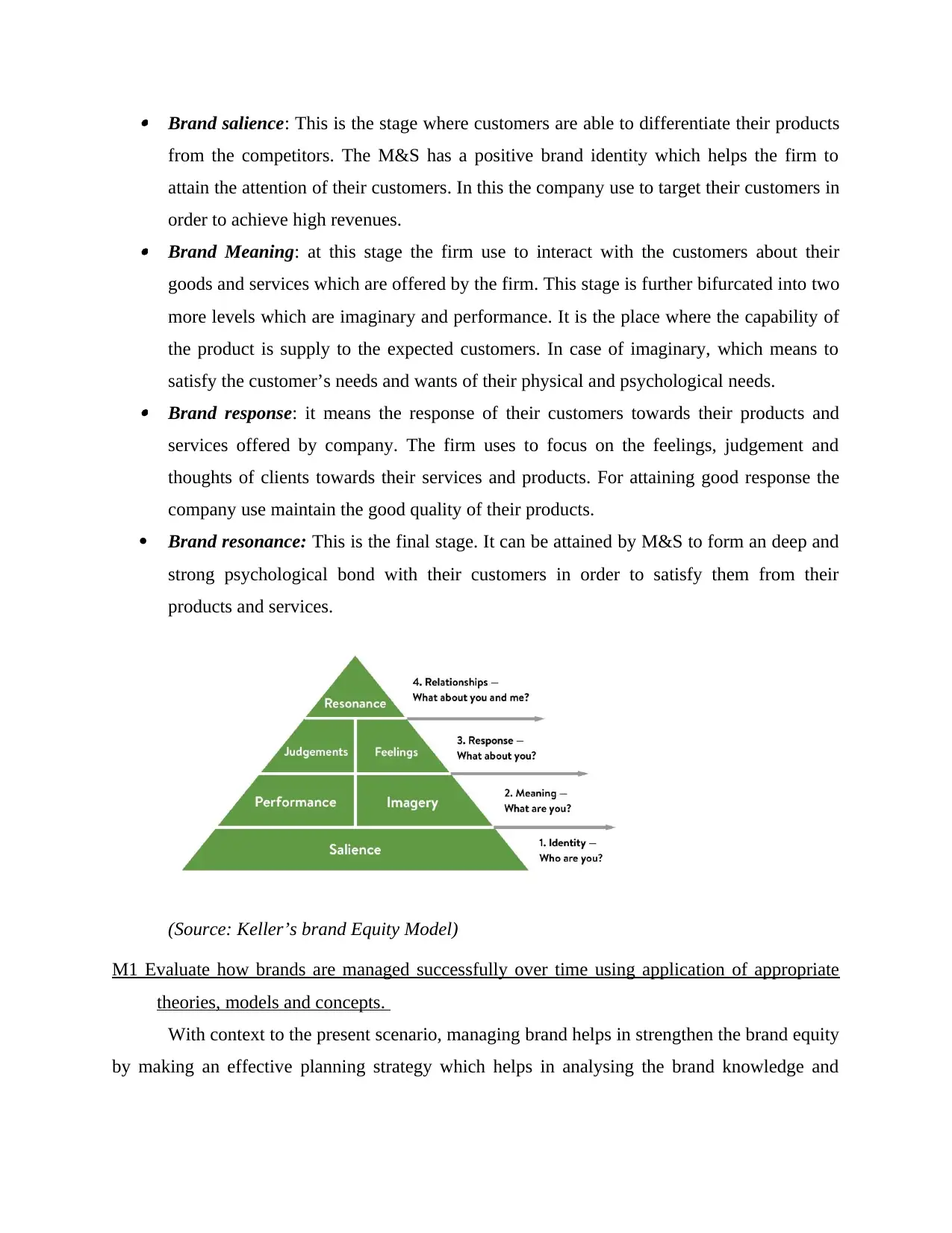
Brand salience: This is the stage where customers are able to differentiate their products
from the competitors. The M&S has a positive brand identity which helps the firm to
attain the attention of their customers. In this the company use to target their customers in
order to achieve high revenues. Brand Meaning: at this stage the firm use to interact with the customers about their
goods and services which are offered by the firm. This stage is further bifurcated into two
more levels which are imaginary and performance. It is the place where the capability of
the product is supply to the expected customers. In case of imaginary, which means to
satisfy the customer’s needs and wants of their physical and psychological needs. Brand response: it means the response of their customers towards their products and
services offered by company. The firm uses to focus on the feelings, judgement and
thoughts of clients towards their services and products. For attaining good response the
company use maintain the good quality of their products.
Brand resonance: This is the final stage. It can be attained by M&S to form an deep and
strong psychological bond with their customers in order to satisfy them from their
products and services.
(Source: Keller’s brand Equity Model)
M1 Evaluate how brands are managed successfully over time using application of appropriate
theories, models and concepts.
With context to the present scenario, managing brand helps in strengthen the brand equity
by making an effective planning strategy which helps in analysing the brand knowledge and
from the competitors. The M&S has a positive brand identity which helps the firm to
attain the attention of their customers. In this the company use to target their customers in
order to achieve high revenues. Brand Meaning: at this stage the firm use to interact with the customers about their
goods and services which are offered by the firm. This stage is further bifurcated into two
more levels which are imaginary and performance. It is the place where the capability of
the product is supply to the expected customers. In case of imaginary, which means to
satisfy the customer’s needs and wants of their physical and psychological needs. Brand response: it means the response of their customers towards their products and
services offered by company. The firm uses to focus on the feelings, judgement and
thoughts of clients towards their services and products. For attaining good response the
company use maintain the good quality of their products.
Brand resonance: This is the final stage. It can be attained by M&S to form an deep and
strong psychological bond with their customers in order to satisfy them from their
products and services.
(Source: Keller’s brand Equity Model)
M1 Evaluate how brands are managed successfully over time using application of appropriate
theories, models and concepts.
With context to the present scenario, managing brand helps in strengthen the brand equity
by making an effective planning strategy which helps in analysing the brand knowledge and
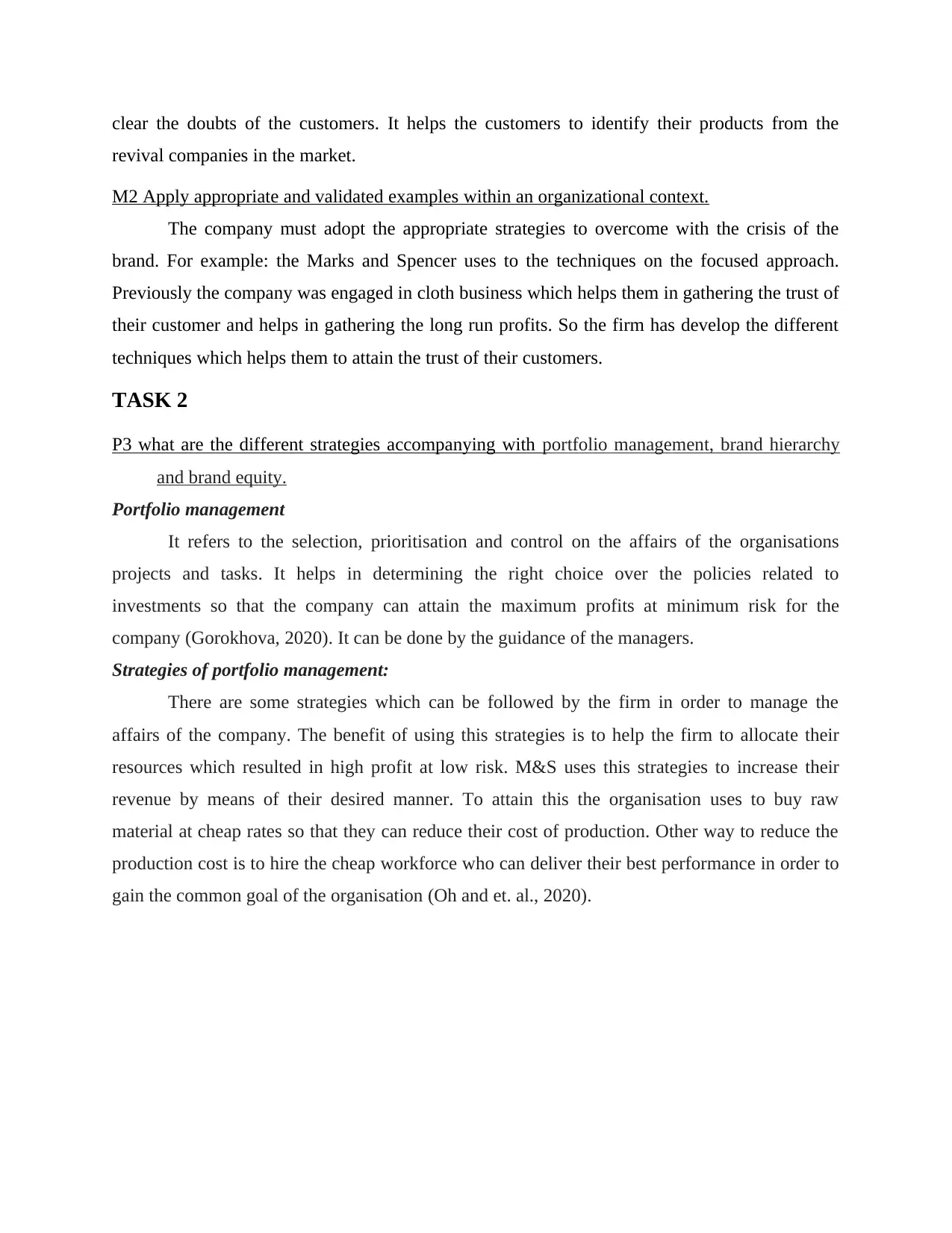
clear the doubts of the customers. It helps the customers to identify their products from the
revival companies in the market.
M2 Apply appropriate and validated examples within an organizational context.
The company must adopt the appropriate strategies to overcome with the crisis of the
brand. For example: the Marks and Spencer uses to the techniques on the focused approach.
Previously the company was engaged in cloth business which helps them in gathering the trust of
their customer and helps in gathering the long run profits. So the firm has develop the different
techniques which helps them to attain the trust of their customers.
TASK 2
P3 what are the different strategies accompanying with portfolio management, brand hierarchy
and brand equity.
Portfolio management
It refers to the selection, prioritisation and control on the affairs of the organisations
projects and tasks. It helps in determining the right choice over the policies related to
investments so that the company can attain the maximum profits at minimum risk for the
company (Gorokhova, 2020). It can be done by the guidance of the managers.
Strategies of portfolio management:
There are some strategies which can be followed by the firm in order to manage the
affairs of the company. The benefit of using this strategies is to help the firm to allocate their
resources which resulted in high profit at low risk. M&S uses this strategies to increase their
revenue by means of their desired manner. To attain this the organisation uses to buy raw
material at cheap rates so that they can reduce their cost of production. Other way to reduce the
production cost is to hire the cheap workforce who can deliver their best performance in order to
gain the common goal of the organisation (Oh and et. al., 2020).
revival companies in the market.
M2 Apply appropriate and validated examples within an organizational context.
The company must adopt the appropriate strategies to overcome with the crisis of the
brand. For example: the Marks and Spencer uses to the techniques on the focused approach.
Previously the company was engaged in cloth business which helps them in gathering the trust of
their customer and helps in gathering the long run profits. So the firm has develop the different
techniques which helps them to attain the trust of their customers.
TASK 2
P3 what are the different strategies accompanying with portfolio management, brand hierarchy
and brand equity.
Portfolio management
It refers to the selection, prioritisation and control on the affairs of the organisations
projects and tasks. It helps in determining the right choice over the policies related to
investments so that the company can attain the maximum profits at minimum risk for the
company (Gorokhova, 2020). It can be done by the guidance of the managers.
Strategies of portfolio management:
There are some strategies which can be followed by the firm in order to manage the
affairs of the company. The benefit of using this strategies is to help the firm to allocate their
resources which resulted in high profit at low risk. M&S uses this strategies to increase their
revenue by means of their desired manner. To attain this the organisation uses to buy raw
material at cheap rates so that they can reduce their cost of production. Other way to reduce the
production cost is to hire the cheap workforce who can deliver their best performance in order to
gain the common goal of the organisation (Oh and et. al., 2020).
⊘ This is a preview!⊘
Do you want full access?
Subscribe today to unlock all pages.

Trusted by 1+ million students worldwide
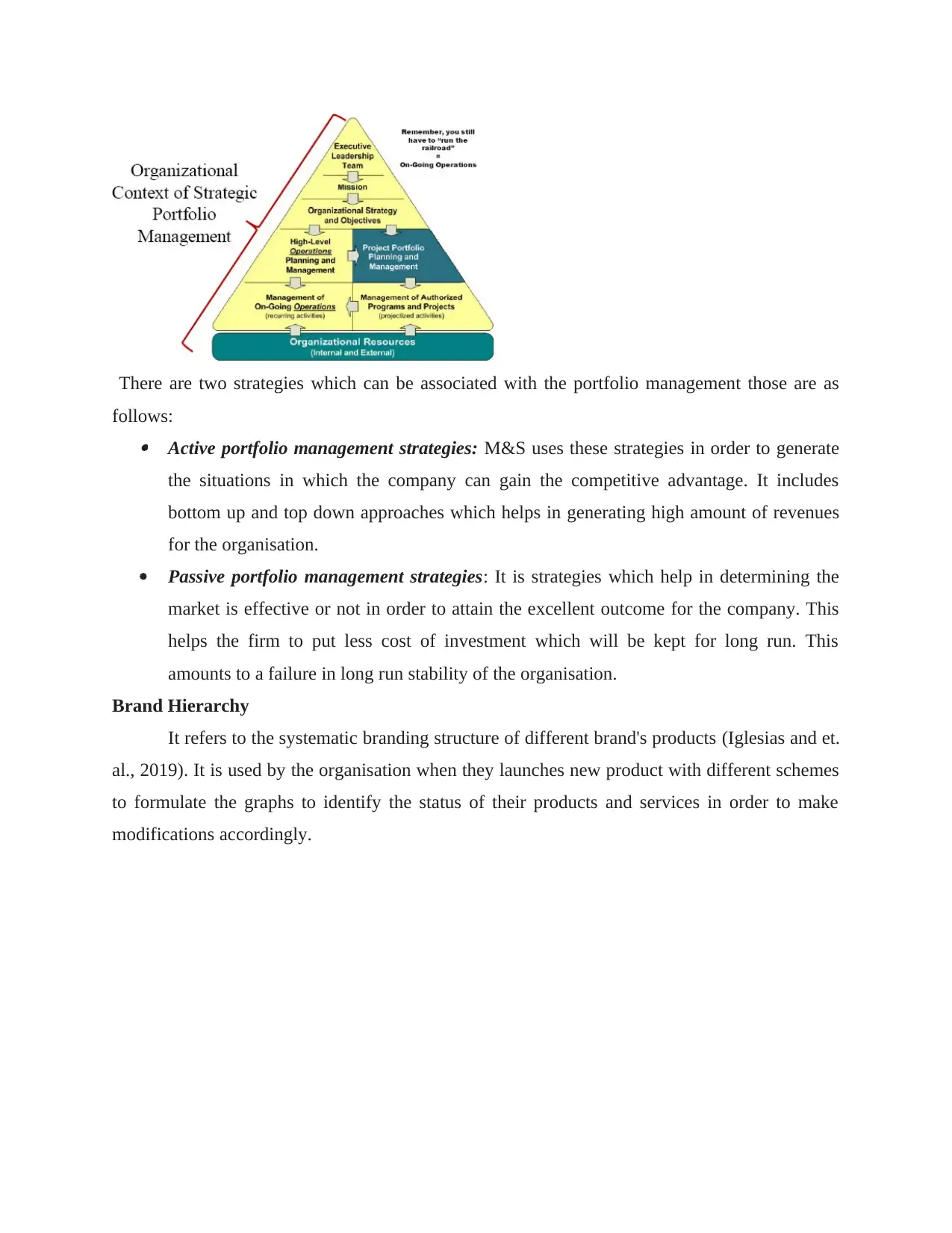
There are two strategies which can be associated with the portfolio management those are as
follows: Active portfolio management strategies: M&S uses these strategies in order to generate
the situations in which the company can gain the competitive advantage. It includes
bottom up and top down approaches which helps in generating high amount of revenues
for the organisation.
Passive portfolio management strategies: It is strategies which help in determining the
market is effective or not in order to attain the excellent outcome for the company. This
helps the firm to put less cost of investment which will be kept for long run. This
amounts to a failure in long run stability of the organisation.
Brand Hierarchy
It refers to the systematic branding structure of different brand's products (Iglesias and et.
al., 2019). It is used by the organisation when they launches new product with different schemes
to formulate the graphs to identify the status of their products and services in order to make
modifications accordingly.
follows: Active portfolio management strategies: M&S uses these strategies in order to generate
the situations in which the company can gain the competitive advantage. It includes
bottom up and top down approaches which helps in generating high amount of revenues
for the organisation.
Passive portfolio management strategies: It is strategies which help in determining the
market is effective or not in order to attain the excellent outcome for the company. This
helps the firm to put less cost of investment which will be kept for long run. This
amounts to a failure in long run stability of the organisation.
Brand Hierarchy
It refers to the systematic branding structure of different brand's products (Iglesias and et.
al., 2019). It is used by the organisation when they launches new product with different schemes
to formulate the graphs to identify the status of their products and services in order to make
modifications accordingly.
Paraphrase This Document
Need a fresh take? Get an instant paraphrase of this document with our AI Paraphraser
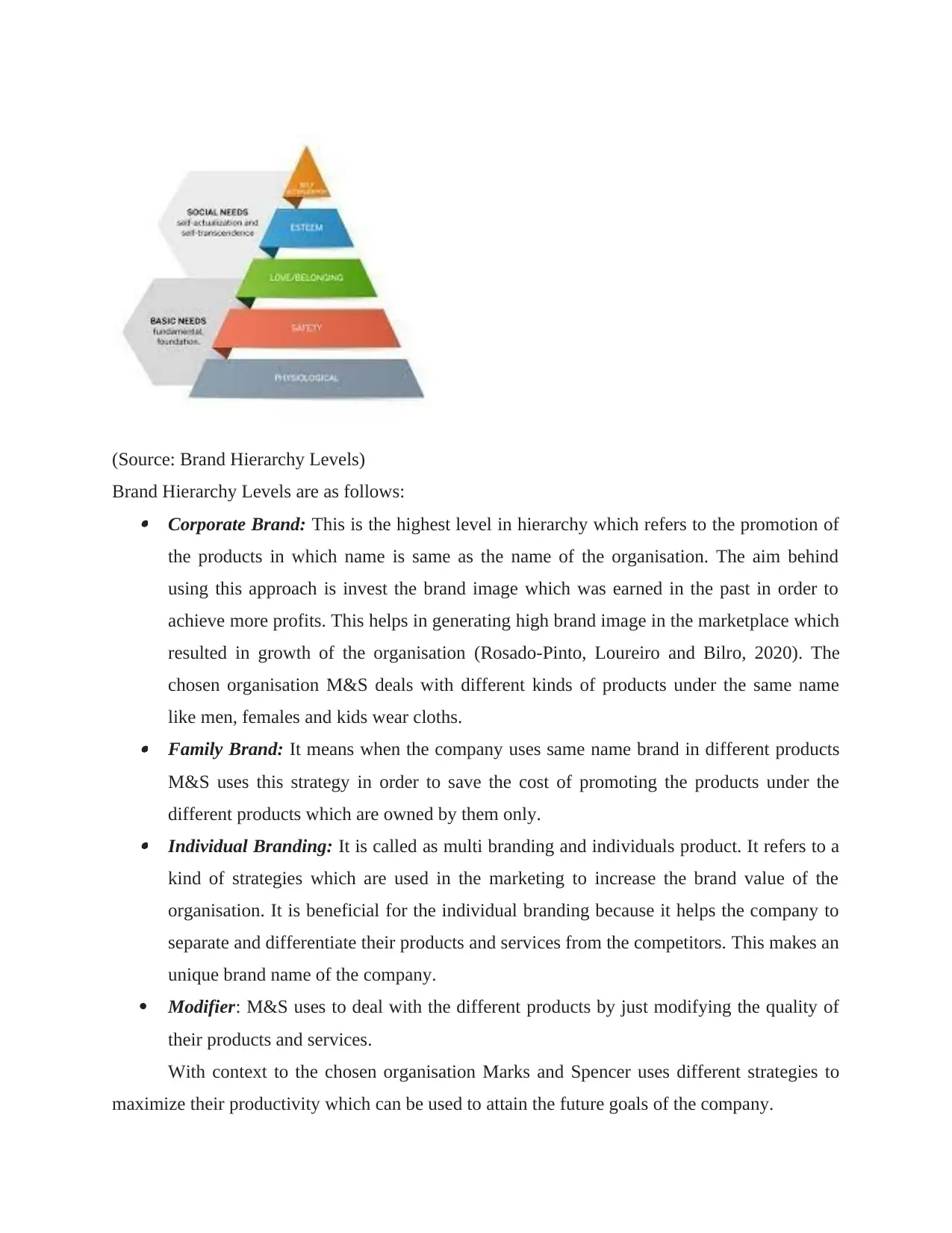
(Source: Brand Hierarchy Levels)
Brand Hierarchy Levels are as follows: Corporate Brand: This is the highest level in hierarchy which refers to the promotion of
the products in which name is same as the name of the organisation. The aim behind
using this approach is invest the brand image which was earned in the past in order to
achieve more profits. This helps in generating high brand image in the marketplace which
resulted in growth of the organisation (Rosado-Pinto, Loureiro and Bilro, 2020). The
chosen organisation M&S deals with different kinds of products under the same name
like men, females and kids wear cloths. Family Brand: It means when the company uses same name brand in different products
M&S uses this strategy in order to save the cost of promoting the products under the
different products which are owned by them only. Individual Branding: It is called as multi branding and individuals product. It refers to a
kind of strategies which are used in the marketing to increase the brand value of the
organisation. It is beneficial for the individual branding because it helps the company to
separate and differentiate their products and services from the competitors. This makes an
unique brand name of the company.
Modifier: M&S uses to deal with the different products by just modifying the quality of
their products and services.
With context to the chosen organisation Marks and Spencer uses different strategies to
maximize their productivity which can be used to attain the future goals of the company.
Brand Hierarchy Levels are as follows: Corporate Brand: This is the highest level in hierarchy which refers to the promotion of
the products in which name is same as the name of the organisation. The aim behind
using this approach is invest the brand image which was earned in the past in order to
achieve more profits. This helps in generating high brand image in the marketplace which
resulted in growth of the organisation (Rosado-Pinto, Loureiro and Bilro, 2020). The
chosen organisation M&S deals with different kinds of products under the same name
like men, females and kids wear cloths. Family Brand: It means when the company uses same name brand in different products
M&S uses this strategy in order to save the cost of promoting the products under the
different products which are owned by them only. Individual Branding: It is called as multi branding and individuals product. It refers to a
kind of strategies which are used in the marketing to increase the brand value of the
organisation. It is beneficial for the individual branding because it helps the company to
separate and differentiate their products and services from the competitors. This makes an
unique brand name of the company.
Modifier: M&S uses to deal with the different products by just modifying the quality of
their products and services.
With context to the chosen organisation Marks and Spencer uses different strategies to
maximize their productivity which can be used to attain the future goals of the company.
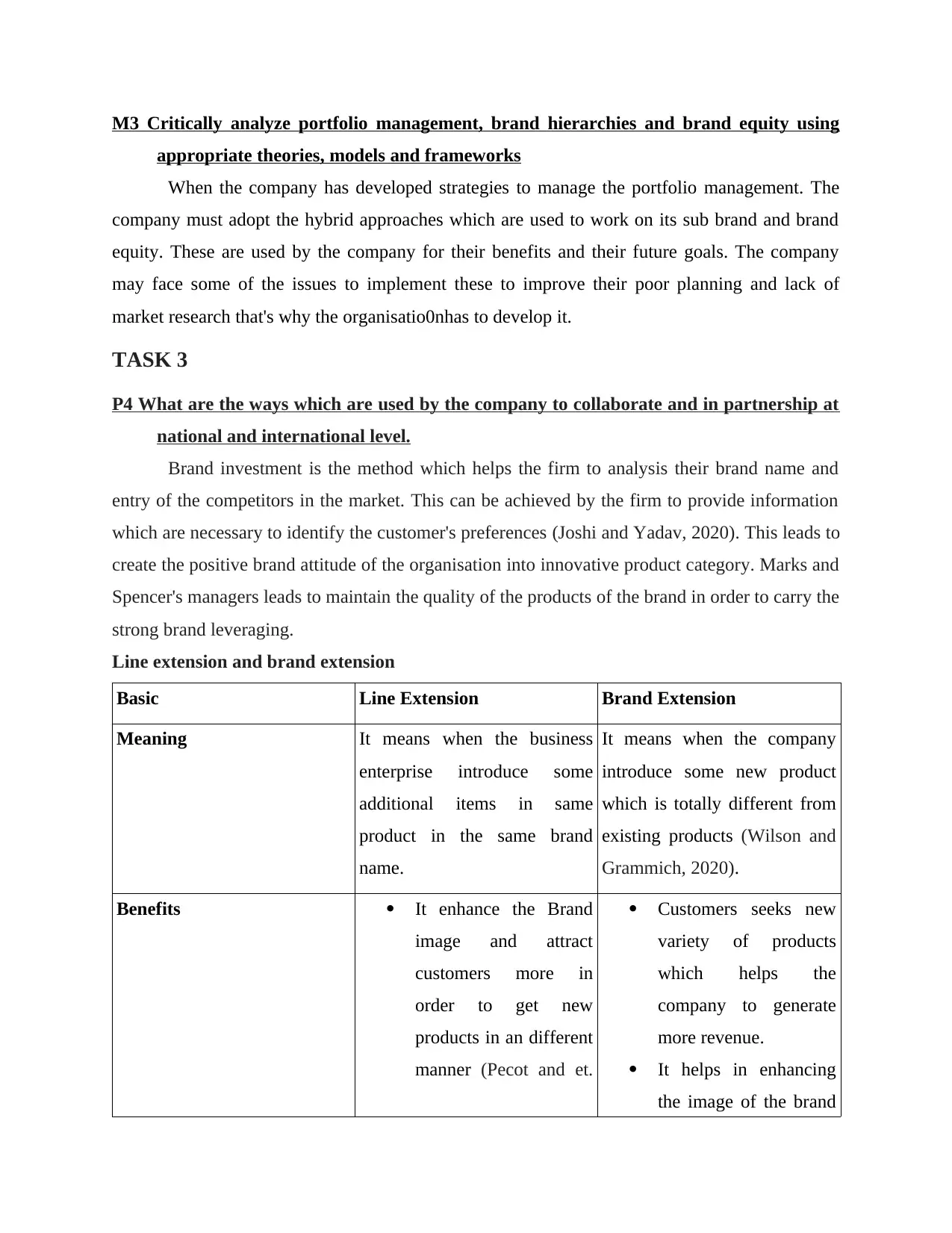
M3 Critically analyze portfolio management, brand hierarchies and brand equity using
appropriate theories, models and frameworks
When the company has developed strategies to manage the portfolio management. The
company must adopt the hybrid approaches which are used to work on its sub brand and brand
equity. These are used by the company for their benefits and their future goals. The company
may face some of the issues to implement these to improve their poor planning and lack of
market research that's why the organisatio0nhas to develop it.
TASK 3
P4 What are the ways which are used by the company to collaborate and in partnership at
national and international level.
Brand investment is the method which helps the firm to analysis their brand name and
entry of the competitors in the market. This can be achieved by the firm to provide information
which are necessary to identify the customer's preferences (Joshi and Yadav, 2020). This leads to
create the positive brand attitude of the organisation into innovative product category. Marks and
Spencer's managers leads to maintain the quality of the products of the brand in order to carry the
strong brand leveraging.
Line extension and brand extension
Basic Line Extension Brand Extension
Meaning It means when the business
enterprise introduce some
additional items in same
product in the same brand
name.
It means when the company
introduce some new product
which is totally different from
existing products (Wilson and
Grammich, 2020).
Benefits It enhance the Brand
image and attract
customers more in
order to get new
products in an different
manner (Pecot and et.
Customers seeks new
variety of products
which helps the
company to generate
more revenue.
It helps in enhancing
the image of the brand
appropriate theories, models and frameworks
When the company has developed strategies to manage the portfolio management. The
company must adopt the hybrid approaches which are used to work on its sub brand and brand
equity. These are used by the company for their benefits and their future goals. The company
may face some of the issues to implement these to improve their poor planning and lack of
market research that's why the organisatio0nhas to develop it.
TASK 3
P4 What are the ways which are used by the company to collaborate and in partnership at
national and international level.
Brand investment is the method which helps the firm to analysis their brand name and
entry of the competitors in the market. This can be achieved by the firm to provide information
which are necessary to identify the customer's preferences (Joshi and Yadav, 2020). This leads to
create the positive brand attitude of the organisation into innovative product category. Marks and
Spencer's managers leads to maintain the quality of the products of the brand in order to carry the
strong brand leveraging.
Line extension and brand extension
Basic Line Extension Brand Extension
Meaning It means when the business
enterprise introduce some
additional items in same
product in the same brand
name.
It means when the company
introduce some new product
which is totally different from
existing products (Wilson and
Grammich, 2020).
Benefits It enhance the Brand
image and attract
customers more in
order to get new
products in an different
manner (Pecot and et.
Customers seeks new
variety of products
which helps the
company to generate
more revenue.
It helps in enhancing
the image of the brand
⊘ This is a preview!⊘
Do you want full access?
Subscribe today to unlock all pages.

Trusted by 1+ million students worldwide
1 out of 19
Related Documents
Your All-in-One AI-Powered Toolkit for Academic Success.
+13062052269
info@desklib.com
Available 24*7 on WhatsApp / Email
![[object Object]](/_next/static/media/star-bottom.7253800d.svg)
Unlock your academic potential
Copyright © 2020–2025 A2Z Services. All Rights Reserved. Developed and managed by ZUCOL.




